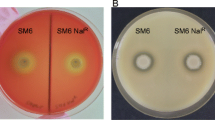Abstract
Three strains of Cladosporium carrionii, two human isolates and one from a xerophilous plant, were used to study the effect of culture conditions in 106 newborn ddY mice. Growth in a complex medium (YPG) and a basal synthetic medium (BSM) was compared. Filamentous forms developed during static incubation while conidia were readily formed with shaking. Mice inoculated intraperitoneally were sacrified and autopsied after 4 weeks. Mortality was related only to sporulated exponential phase growing cells. Invasiveness ability was preserved in all experimental conditions. BSM medium that inhibited exopigment formation appeared more suitable than YPG to obtain intact cells for further studies.
Biochemical and physiological alteration associated with shape changes during differentiation of vegetative cells into spores could play an important role in virulence of C. carrionii
Similar content being viewed by others
References
Albornoz MB, Marin C, Iwatsu T. Estudio epidemiológico de un área endémica para Cromomicosis en el Estado Falcón. Invest Clin 1982; 23(4): 219–28.
Brygoo ER, Destombes P. Epidemiologie de la chromoblastomycose humaine. Bull Inst Pasteur 1967; 74: 219–43.
Yegres, F. Richard — Yegres, N, Medina-Ruiz E., González-Vivas, R. Cromomicosis por Cladosporium carrionii en criadores de caprinos. Invest Clinica 1985; 26(4): 235–46.
Szaniszlo PJ, Jacobs CW, Geiss A. Dimorphism: Morphological and Biochemical aspects. In: Dexter H. Howard, eds. Fungi pathogenic for humans and animals. New York: Marcel Dekker 1983: 380.
Nishimura K, Miyaji M, Taguchi H, Wang DL, Li RY, Meng ZH. An ecological study on pathogenic dematiacœus fungi in China. Proceedings of the Fourth Inter. Symposium of the Research Center for Pathogenic fungi and Microbial Toxicoses. Chiba University 1989; 17–20.
Richard-Yegres N, Yegres F. Cladosporium carrionii en vegetation xerofila: aislamiento en una zona endemica para la cromomicosis en Venezuela. Dermat Venez 1987; 15–8.
Mandels M, Parrish FW, Reese ET. Sophorose as an inducer of cellulase in Trichoderma viride. J Bacteriol 1962; 83(2): 400–8.
Trinder P. Determination of blood glucose using 4-aminophenazone as oxygen acceptor. J Clin Pathol 1969; 22(2): 246.
Borelli D. A method for producing chromomycosis in mice. Trans R Soc Trop Med Hyg 1972; 66(5): 793–4.
Souza ET, Silva-filho FC, De Souza W, Alviano CS, Angluster J, Trasvassos LR. Identification of sialic acids on cell surface of hyphae and conidia of human pathogen Fonsecaea pedrosoi. J Med Vet Mycol 1986; 24: 145–53.
Taylor BE, Wheeler MH. Evidence for pentaketide melanin biosynthesis in dematiaceous human pathogenic fungi. Mycologia 1987; 79(2): 320–2.
Friis J, Ottolenghi P. Pigment formation by the ‘black yeast’, Phialophora jeanselmei. Antonie van Leeuwenhoek — J Supplement Yeast Symposium 1969; 35: H13-H14.
Reiss E, Nickerson WJ. Characterization of two melanins produced by Phialophora verrucosa. Sabouraudia 1971; 12: 193–201.
Dixon DM, Polak A, Szaniszlo PJ. Pathogenicity and virulence of wild-type and melanin-deficient Wangiella dermatitidis. J Med Vet Mycol 1986; 24: 145–53.
Watanabe S. Animals models of cutaneous and subcutaneous mycoses. In: Animals models in medical mycology. Boca Raton, Florida: C.R.C. Press 1987: 35.
Miyaji M, Nishimura K. Experimental fungal infections. In: Animals models in medical mycology. Boca Raton, Florida: C.R.C. Press 1987: 9–11.
Author information
Authors and Affiliations
Rights and permissions
About this article
Cite this article
Yegres, F., Richard-Yegres, N., Nishimura, K. et al. Virulence and pathogenicity of human and environmental isolates of Cladosporium carrionii in new born ddY mice. Mycopathologia 114, 71–76 (1991). https://doi.org/10.1007/BF00436424
Received:
Accepted:
Issue Date:
DOI: https://doi.org/10.1007/BF00436424




